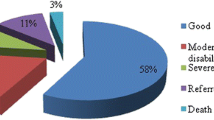Abstract
Purpose
The development of a contralateral extraaxial hematoma has repeatedly been described in small series and descriptive studies. However, the evidence available to date is limited.
Objectives
To evaluate the incidence and risk factors leading to the development of a contralateral extraaxial hematoma and to describe the characteristics of cases.
Methods
A retrospective cohort study with prospective data collection was undertaken. All patients admitted to an intensive care unit (ICU) from 2006 to 2010 were studied. The inclusion criteria were as follows: severe trauma [Injury Severity Score (ISS ≥ 16)], neurosurgery (NeuroSx) in the first 24 h. The following were excluded: subacute/chronic subdural hematomas, first bilateral NeuroSx. Cases were those who required immediate contralateral NeuroSx after the first NeuroSx due to the occurrence of a new extraaxial injury or significant growth of a previous one. Controls were those patients those who did not require second NeuroSx or who required reoperation due to ipsilateral lesions. The variables considered were: demographics, neurological assessment, traumatic injuries and severity, image and surgical findings, clinical course, and outcome. Statistics analysis comprised descriptive, inferential, and multivariate analysis by logistic regression.
Results
A total of 120 patients were included, among which there were 11 cases (incidence 9.2 %). The cases showed a significantly higher frequency of coma or severe traumatic brain injury (TBI) at admission, contralateral injury and contralateral skull fracture in the preoperative computed tomography (CT) scan, as well as decompressive craniectomy. There were no significant differences in the severity scores, clinical course, or outcomes. The presence of contralateral fracture was identified as an independent risk factor [relative risk (RR) 47.9, 95 % confidence interval (CI) 5.2–443].
Conclusions
Contralateral extraaxial hematoma is a rare entity, although it has a high mortality rate. Therefore, it requires a high index of suspicion, especially in patients with severe TBI, with minimal contralateral injury and mainly with contralateral skull fracture on the initial CT scan.

Similar content being viewed by others
References
Koulouris S, Rizzoli HV. Acute bilateral extradural hematoma: case report. Neurosurgery. 1980;7:608–10.
Piepmeier JM, Wagner FC Jr. Delayed post-traumatic extracerebral hematomas. J Trauma. 1982;22:455–60.
Lesoin F, Viaud C, Pruvo J, Redford H, Jomin M. Traumatic and alternating delayed intracranial hematomas. Neuroradiology. 1984;26:515–6.
Reale F, Biancotti R. Acute bilateral epidural hematoma. Surg Neurol. 1985;24:260–2.
Koga H, Mori K, Kurihara M, Sakai S. Traumatic bilateral epidural hematomas presenting at different times in a patient with large ventricles. Surg Neurol. 1985;24:272–4.
Borovich B, Braun J, Guilburd JN, Zaaroor M, Michich M, Levy L, et al. Delayed onset of traumatic extradural hematoma. J Neurosurg. 1985;63:30–4.
Meguro K, Kobayashi E, Maki Y. Acute brain swelling during evacuation of subdural haematoma caused by delayed contralateral extradural hematoma: report of two cases. Neurosurgery. 1987;20:326–8.
Thibodeau M, Melanson D, Ethier R. Acute epidural hematoma following decompressive surgery of a subdural hematoma. Can Assoc Radiol J. 1987;38:52–3.
Feuerman T, Wackym PA, Gade GF, Lanman T, Becker D. Intraoperative development of contralateral epidural hematoma during evacuation of traumatic extraaxial hematoma. Neurosurgery. 1988;23:480–4.
Ban M, Agawa M, Fukami T. Delayed evolution of post-traumatic contralateral extracerebral hematoma after evacuation of initial hematoma. Neurol Med Chir (Tokyo). 1991;31:927–30.
Matsuno A, Katayama H, Wada H, Morikawa K, Tanaka K, Tanaka H, et al. Significance of consecutive bilateral surgeries for patients with acute subdural hematoma who develop contralateral acute epi- or subdural hematoma. Surg Neurol. 2003;60:23–30.
Mohindra S, Mukherjee KK, Gupta R, Chhabra R, Gupta SK, Khosla VK. Decompressive surgery for acute subdural haematoma leading to contralateral extradural haematoma: a report of two cases and review of literature. Br J Neurosurg. 2005;19:490–4.
Su TM, Lee TH, Chen WF, Lee TC, Cheng CH. Contralateral acute epidural hematoma after decompressive surgery of acute subdural hematoma: clinical features and outcome. J Trauma. 2008;65(6):1298–302.
Cohen JE, Rajz G, Itshayek E, Umansky F. Bilateral acute epidural hematoma after evacuation of acute subdural hematoma: brain shift and the dynamics of extraaxial collections. Neurol Res. 2004;26:763–6.
Brain Trauma Foundation. 2007. Guidelines for the management of severe traumatic brain injury. 3rd ed. http://www.braintrauma.org/pdf/protected/Guidelines_Management_2007w_bookmarks.pdf. Accessed 31 Oct 2012.
Stiver SI. Complications of decompressive craniectomy for traumatic brain injury. Neurosurg Focus. 2009;26(6):E7.
Lang JK, Ludwig HC, Mursch K, Zimmerer B, Markakis E. Elevated cerebral perfusion pressure and low colloid osmotic pressure as a risk factor for subdural space-occupying hygromas? Surg Neurol. 1999;52:630–7.
Jeon SW, Choi JH, Jang TW, Moon SM, Hwang HS, Jeong JH. Risk factors associated with subdural hygroma after decompressive craniectomy in patients with traumatic brain injury: a comparative study. J Korean Neurosurg Soc. 2011;49(6):355–8.
Aarabi B, Chesler D, Maulucci C, Blacklock T, Alexander M. Dynamics of subdural hygroma following decompressive craniectomy: a comparative study. Neurosurg Focus. 2009;26(6):E8.
Huang APH, Chen YC, Hu CK, Lin TK, Huang SJ, Tu YK, et al. Intraoperative sonography for detection of contralateral acute epidural or subdural hematoma after decompressive surgery (letter). J Trauma. 2011;70(6):1578–9.
Petersen OF, Espersen JO. Extradural hematomas: measurement of size by volume summation on CT scanning. Neuroradiology. 1984;26:363–7.
Jennett B, Bond M. Assessment of outcome after severe brain damage: a practical scale. Lancet. 1975;1:480–4.
Acknowledgments
We are indebted to the staff of the Trauma Intensive Care Unit (TICU) of Hospital Universitario 12 de Octubre, who have made this study possible.
Conflict of interest
On behalf of all authors, the corresponding author states that there is no conflict of interest.
Author information
Authors and Affiliations
Corresponding author
Rights and permissions
About this article
Cite this article
Flordelís Lasierra, J.L., García Fuentes, C., Toral Vázquez, D. et al. Contralateral extraaxial hematomas after urgent neurosurgery of a mass lesion in patients with traumatic brain injury. Eur J Trauma Emerg Surg 39, 277–283 (2013). https://doi.org/10.1007/s00068-013-0268-4
Received:
Accepted:
Published:
Issue Date:
DOI: https://doi.org/10.1007/s00068-013-0268-4




